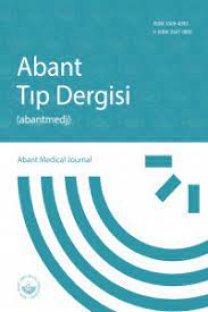Histerektomi Materyallerinde Histopatolojik Tanıların İncelenmesi
Histerektomi, Endikasyon, Patoloji
The Evaluation of Histopathologic Diagnosis in Specimens of Hysterectomy
Hysterectomy, Indication, Pathology,
___
- Benrubi GI. History of hysterectomy. J Fla Med Assoc, ; 75: 533-8. Pokras R. Hysterectomy, past, present and future. Stat Bull Metrop Insur Co, 1989: 7012-21.
- Davies A, Magos A. Indications and alternatives to hysterectomy. Bailliere’s Clin Obstet and Gynaecol 1997; : 64- 7.
- Coulter A, Bradlow J, Agass M, Martin-Bates C, Tulloch A. Outcomes of referrals to gynaecology outpatient clinics for menstrual problems: an audit of general practice records. Br J Obstet Gynaecol 1991; 98: 789-96.
- Vessey MP, Villard-Mackintosh L, McPherson K, Coul- ter A, Yeats D. The epidemiology of hysterectomy: find- ings in a large cohort study. Br J Obstet Gynecol 1992; 99: 7.
- Rock AJ, Jones WH (eds). Te Linde’s Operative Gyne- cology 9th ed. Chap 30. Philadelphia: Wiliams & Wilkins Lippincott 2003; 753-98.
- Lepine LA, Hillis SD, Marchbanks PA, Koonin LM, Mor- row B, Kieke BA, Wilcox LS. Hysterectomy surveillance- United States 1980-1997. MMWR 1997; 46: 1-15.
- Cramer SF, Patel A. The frequency of uterine leiomyo- mas. Am J Clin Pathol 1990; 94: 435-8.
- Dinçgez B, Coşkun Eİ, Ayanoğlu YT. Kliniğimizde gerçekleştirilen histerektomi olgularının değerlendirilme- si. Şişli Etfal Hastanesi Tıp Bülteni 2011; 45: 35-8.
- Bukhari U, Sadiq S. Analysis of the underlying patho- logical lesions in hysterectomy specimens. Pak J Pathol ; 18: 110-12. Ojeda VJ. The pathology of hysterectomy specimens. Z Med J 1979; 89: 169-71.
- Atılgan R, Boztosun A, Ozercan MR. Histerektomi materyallerinde histopatolojik tanıların insidansı. Fırat Tıp Dergisi 2012; 17: 19-229.
- Atri M, Reinhold C, Mehio AR, Chapman WB, Bret PM. Adenomyosis: US features with histologic correlation in an invitro study. Radiology 2000; 215: 783-90.
- Kunz G, Beil D, Huppert P, Noe M, Kissler S, Leyen- decker G. Adenomyosis in endometriosis prevalence and impact on fertility. Evidence from magnetic resonance imaging. Hum Reprod 2005; 20: 2309-16.
- Çakmak B, Özsoy Z, Hısım Y, Nacar M, Metin FZ, Demirtürk F. Benign endikasyonlar nedeniyle uygulanan histerektomi materyallerinde adenomyozis sıklığı. Çağdaş Tıp Dergisi 2012; 2: 158-161.
- Lee NC, Dicker RC, Rubin GL, Ory HW. Confirmation of the preoperative diagnoses for hysterectomy. Am J Obstet Gynecol 1984; 150: 283-7.
- Kurman RJ, Kaminski PF, Norris HJ. The behavior of endometrial hyperplasia. A long term study of ‘untreated’ hyperplasia in 170 patients. Cancer 1985; 56: 403–12.
- Terakawa N, Kigawa J, Taketani Y, Yoshikawa H, Yaji- ma A, Noda K et al. The behavior of endometrial hyper- plasia: a prospective study. Endometrial Hyperplasia Study Group. J Obstet Gynaecol Res 1997; 23: 223–30.
- Sherman ME, Mazur MT, Kurman RJ. Benign diseases of the endometrium. In: Kurman RJ, editor. Blaunstein’s pathology of the female genital tract. 5. edition. New York: Springer, 2002; 421–66.
- Reslova T, Tosner J, Resl M, Kugler R, Vavrova I. En- dometrial polyps. A clinical study of 245 cases. Arch Gy- necol Obstet 1999; 262: 133-9.
- Shegill SK, Shergill HK. Clinicopathological study of hysterectomies. J Indian Med Assoc 2002; 100: 238-9.
- Talukder SI, Haque MA, Hug MH, Alam MO, Roushan A, Noor Z, Nahar K. Histopathological analysis of hysterec- tomy specimens. Mymensing Med J 2007; 16: 81-4.
- Yayın Aralığı: Yılda 6 Sayı
- Başlangıç: 2012
- Yayıncı: Bolu Abant İzzet Baysal Üniversitesi Tıp Fakültesi Dekanlığı
Kronik Eozinofilik Pnömoni: iki olgu sunumu
Adile Berna DURSUN, Özlem KuRT KAR, Ferda ERKEKOL ÖNER
Transversus Abdominis Plan TAP Bloğu
Ümit Yaşar TEKELİOĞLU, Abdullah DEMİRHAN, Hasan KOÇOĞLU
Transversus abdominis plan (TAP) bloğu
Hasan KOÇOĞLU, Abdullah DEMİRHAN, Ümit Yaşar TEKELİOĞLU
Ümran KOÇAK, Göktürk İPEK, Derya TOK
Esansiyel Trombositemi’li bir hastada Sistemik Lupus Eritematozus
Gökhan ERBAG, İbrahim Hakkı DURSUN, Yıldıray TOPÇU, İlhan DOLAŞIK, Selçuk Yusuf ŞENER
Hamilelikte Ve Sonrasında Geçmeyen Parmak Ağrısının Nadir Bir Nedeni: Osteokondrom
Cengiz IŞIK, Hüsamettin ÇAKICI, Recai ÖZKILIÇ
Esra KOÇOĞLU, Tekin TAŞ, Özlem BUCAK, Fırat Zafer MENGELOĞLU
Çocukluk Çağı İdrar Yolu Enfeksiyonlarında Etken Mikroorganizmalar Ve Antibiyotik Duyarlılıkları
Selma AYDIN ALİM, Nilgün ÇAKIR, Beyhan KÜÇÜKBAYRAK
Ülseratif Kolit Hastasında Nadir Yerleşimli Dijital Tromboemboli Olgusu
Haldun SELÇUK, Asuman ÇELİKBİLEK, Mehmet ÇELİKBİLEK, Yunus Keser YILMAZ, Aylin OKUR
Headache frequency among the health care workers and the relationship working conditions
Süber DİKİCİ, Nurten ERCAN, Gülşen ATAR, Güven ARSLAN, Aylin YILMAZ, İsmail Hamdi KARA, Davut BALTACI, Ahmet ÇELER
